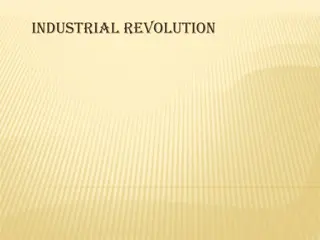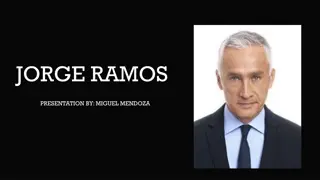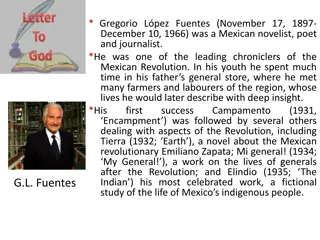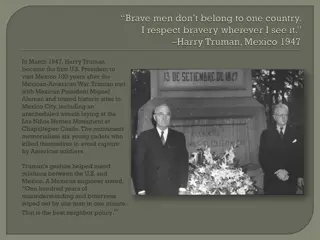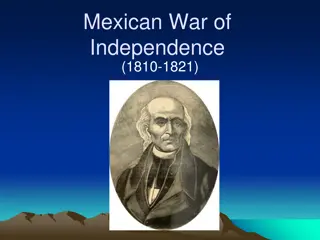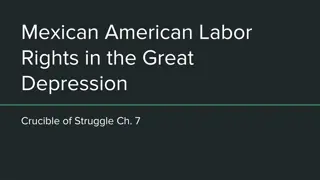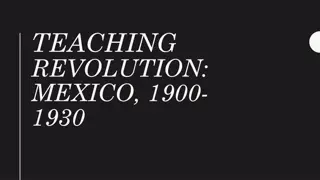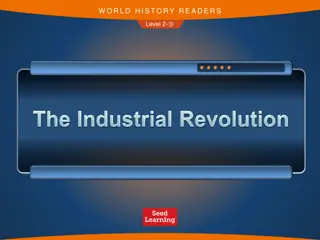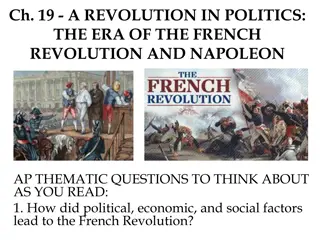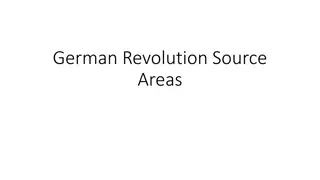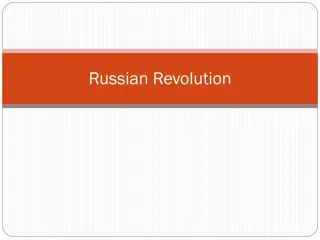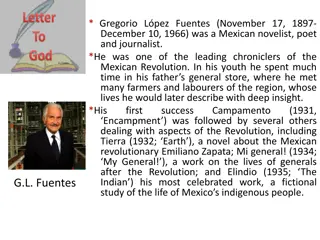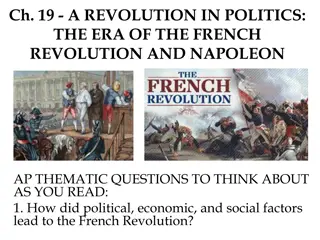Mexican Revolution
Causes of the Mexican Revolution under Porfirio Díaz's rule, start with Francisco Madero's election, spread to include Pancho Villa and Emiliano Zapata, continuation with Huerta's overthrow and Carranza's leadership, and the involvement of women in the revolution. The revolution led to significant political and social changes in Mexico, marked by various rebellions and the enactment of the Mexican Constitution of 1917.
Download Presentation

Please find below an Image/Link to download the presentation.
The content on the website is provided AS IS for your information and personal use only. It may not be sold, licensed, or shared on other websites without obtaining consent from the author.If you encounter any issues during the download, it is possible that the publisher has removed the file from their server.
You are allowed to download the files provided on this website for personal or commercial use, subject to the condition that they are used lawfully. All files are the property of their respective owners.
The content on the website is provided AS IS for your information and personal use only. It may not be sold, licensed, or shared on other websites without obtaining consent from the author.
E N D
Presentation Transcript
Mexican Revolution AP World History
Causes of the Mexican Revolution Reign of Porfirio D az Ruled as a dictator New Creoles Modernized Mexico Masses suppressed Working class wages declined 95% of rural population did not own any land Mestizo population grew rapidly after 1850 Porfirio D az (1876-1910)
Start of the Revolution Election of 1910 Francisco Madero ran against D az D az had Madero arrested on election day Madero called for D az to be overthrown Movement supported by peasants and the middle class D az forced to resign in May 1911 Francisco Madero (1911-1913)
Mexican Revolutionaries (1910) Pancho Villa Francisco Madero
The Revolution Spreads Madero was unprepared Lack of land reforms led to open rebellion Emiliano Zapata Land and Liberty Pancho Villa Madero was overthrown by General Victoriano Huerta in February 1913 Madero was eventually assassinated Pancho Villa Emiliano Zapata Mural to Zapata in Cuba
The Revolution Continues Huerta was opposed by a coalition led by Venustiano Carranza (top), Alvaro Obreg n (bottom), Villa, Zapata, etc. Huerta was overthrown in 1914 Carranza appealed to masses Mexican Constitution of 1917 Villa and Zapata continued to rebel until 1919 and 1920 Carranza was overthrown in 1920 Replaced by Obregon (1920-1924)
Women in the Revolution Intellectuals Called for equal rights, women s suffrage, and other reforms Often endured threats, imprisonment, etc. Soldaderas Served as nurses, cooks, foraged for food, washed clothes and other services Served in the rebel army and the federal army Women Soldiers
Aftermath of Revolution Over one million people died Revolution lacked a plan, a philosophy, intellectual leadership, or political parties Farming, ranching, and mining economies were destroyed Oil industry improved during revolution No major bank or newspaper survived
Constitution of 1917 Conferred strong powers to the president Laid basis for land reform No major redistribution until 1934 Government ownership of mineral and water resources New labor laws No major labor laws until 1931 Placed restrictions on the church and clergy Church went on strike in 1926
Aftermath Continued Alvaro Obreg n (1920-1924) Built schools and encouraged nationalism Diego Rivera Mexico becomes a single-party system Party of Revolutionary Institutions (PRI) Dominated politics until 2000 L zaro C rdenas (1934-1940) Redistributed 45 million acres of land 253 million would be redistributed by 1984 Promoted economic nationalism Nationalized railroads (1937) and oil (1938)





